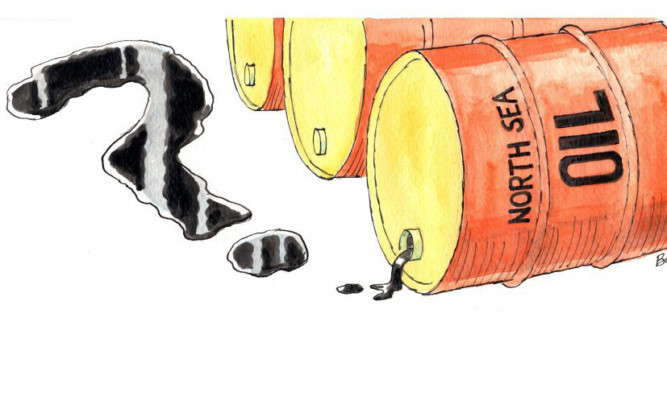
What are a few billion barrels of oil between friends?
The row over how much oil and gas is left in the seas around Scotland is a conundrum which most countries would dearly love to have.
The competing estimates 12, 16 or 24 billion barrels will all generate billions of pounds of tax revenue in the coming decades whether the Union flag continues to fly north of the Border or not.
But the crux of the issue is whether they generate enough cash to keep Scotland’s schools and hospitals open.
The independent Office for Budget Responsibility, set up by the UK Government, has said that for 2016/17 Scotland’s tax take from oil and gas revenues will be £2.9bn.
By contrast, the Scottish Government, using industry figures on how much of the resources they think is left, predicts it will be £6.9bn.
To put that £4bn difference into context, Scotland currently spends £3bn a year on education.
In addition a string of experts have lined up to say the Yes camp are over-egging their forecasts, or as academics from Glasgow University’s Centre for Public Policy for Regions put it the figures are being “skewed in an optimistic manner”.
The renowned Institute of Fiscal Studies has also warned that predictions by Alex Salmond’s Government over North Sea earnings are “too optimistic”.
But both of these organisations are working from the OBR figures, so it is perhaps no surprise they reached the same conclusion.
SNP ministers also point to the OBR’s own track record as being more than shaky, with the body predicting economic growth six times stronger between 2010 and 2012 than subsequent official figures suggest was the case.
To complicate matters even further, industry guru Sir Ian Wood has said both the OBR and Scottish Government are wrong, saying a more realistic estimate for what is left sits between the two of them at 16 billion barrels.
This estimate, crucially, incudes around four billion barrels of oil which has not been found but is likely to be found, such as Clair Ridge field off Shetland.
Neutrals trying to decipher this complex issue also need to know that it is, of course, in the interest of the Scottish Government to talk up oil reserves, and advantageous to Westminster to talk down the value of oil to an independent Scotland.
That there is a lot of oil left is not in doubt. Assuming a geographic share, Scotland has by far the biggest oil reserves in the EU but it is a declining resource and it will not be economical to extract all of it.
There are other considerations too. First, not all of the money to be made from Scotland’s great natural resource will stay in the country, even with a Yes vote.
A recent study showed that nearly all Scotland’s North Sea oil and gas production is licensed to foreign firms. There is only one privately-owned Scottish firm and it produces just 6,000 of the total one million barrels of crude produced every day.
The SNP make great play of what our friends across the North Sea in Norway have done with their oil wealth, sagely putting money aside and investing it instead of propping up their economy from year to year (or electoral cycle to electoral cycle to be more accurate for the UK).
But the crucial difference is the Norwegian government owns a majority stake in the firm exploiting its oil resources.
With most of North Sea profits flowing out of the country, the main route for the state whether it be a separate Scotland or the UK is the taxes levied on oil and gas fields.
Norway puts some of this cash into an oil fund but in the UK it is all spent on Government activity from building roads to propping up the banks.
Many pro-Union politicians will admit, privately of course, that not setting up an oil fund at the time of the first North Sea discoveries was a mistake.
The Yes camp believe it is not too late to rectify this but their own figures show that, initially at least, the cash for such a fund would have to be borrowed.
The potential cloud on the horizon for the oil industry is increasing costs which come with trying to extract oil from more difficult fields.
The Treasury claims the cost of extracting the remaining oil and gas resources “will be in the region of £1 trillion”.
In short, it is getting more expensive to get the stuff out and will continue to do so.
Efficiency has been falling since the reserves in the North Sea peaked more than a decade ago and research by Enders Analysis shows it is now 425% more expensive to extract one barrel of oil equivalent than it was in 2002.
Despite more than £14bn of investment by the industry last year, analysts claim output will not recover strongly because of the growth in small fields to replace the bigger ones reaching the end of their natural lives.
On top of that and this partly explains a drop in revenues over the last year the ageing North Sea infrastructure is frequently shut down for maintenance.
Regardless of the vote’s outcome, it is hoped a new regulator and closer co-operation between companies will boost oil and gas production by up to four billion barrels.
But this good news comes against a backdrop of soaring production costs which show no sign of abating regardless of who wins the referendum.
There are billions of barrels of oil and huge reserves of gas left in the North Sea and it will be these production costs and oil prices rather than political forecasts that will determine how much gets taken out in the coming decades.

Enjoy the convenience of having The Sunday Post delivered as a digital ePaper straight to your smartphone, tablet or computer.
Subscribe for only £5.49 a month and enjoy all the benefits of the printed paper as a digital replica.
Subscribe